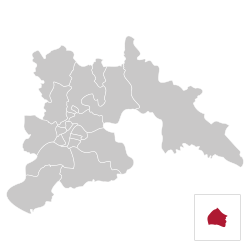Panghyŏn-dong is a neighbourhood that is an exclave of the city of Pyongyang, North Korea, used as a missile base. It is located near the city of Kusong, which it was formerly part of. The neighbourhood became part of Pyongyang in 2018. The area is restricted from foreign entry because of its involvement with the defense industry, and the residents get special treatment in food rations.[1]
Panghyŏn-dong | |
|---|---|
Dong (Neighbourhood) of Pyongyang | |
| Korean transcription(s) | |
| • Hangul | 방현동 |
| • Hanja | 方峴洞 |
| • Revised Romanization | Banghyeon-dong |
| • McCune–Reischauer | Panghyŏn-dong |
 | |
| Dong(Neighbourhood) | North Korea |
| Direct-administered city | P'yŏngyang-Chikhalsi |
| Area | |
• Total | 14.93 km2 (5.76 sq mi) |
History
editIn 1954, Panghyŏn worker's district was created from Nam chang ri and parts of Chong songri,[2] which was part of then Kusong County (which later became Kusong city). The workers district was named as such for the Simbang mountain known in hanja as Panghyon. As a result of the promotion of Kusong county to Kusong city, it became part of Kusong city in 1967.[3] The area was known as Panghyŏn worker's district until 1974, when it was demoted to Dong(neighbourhood).[4]
Missiles
editThe neighbourhood was where the DPRK performed its first test launch of the "Hwasong-14" in 2017.[5]
References
edit- ^ 안준용. "北, 평양서 150km 떨어진 곳을 평양市에 편입 왜?". The Chosun Ilbo. Retrieved 2022-01-30.
- ^ "구성시 개요".
- ^ "방현로동자구".
- ^ "방현동개요".
- ^ "북한 최대 고도 4500km 미사일 발사, 대륙간탄도미사일로 추정".